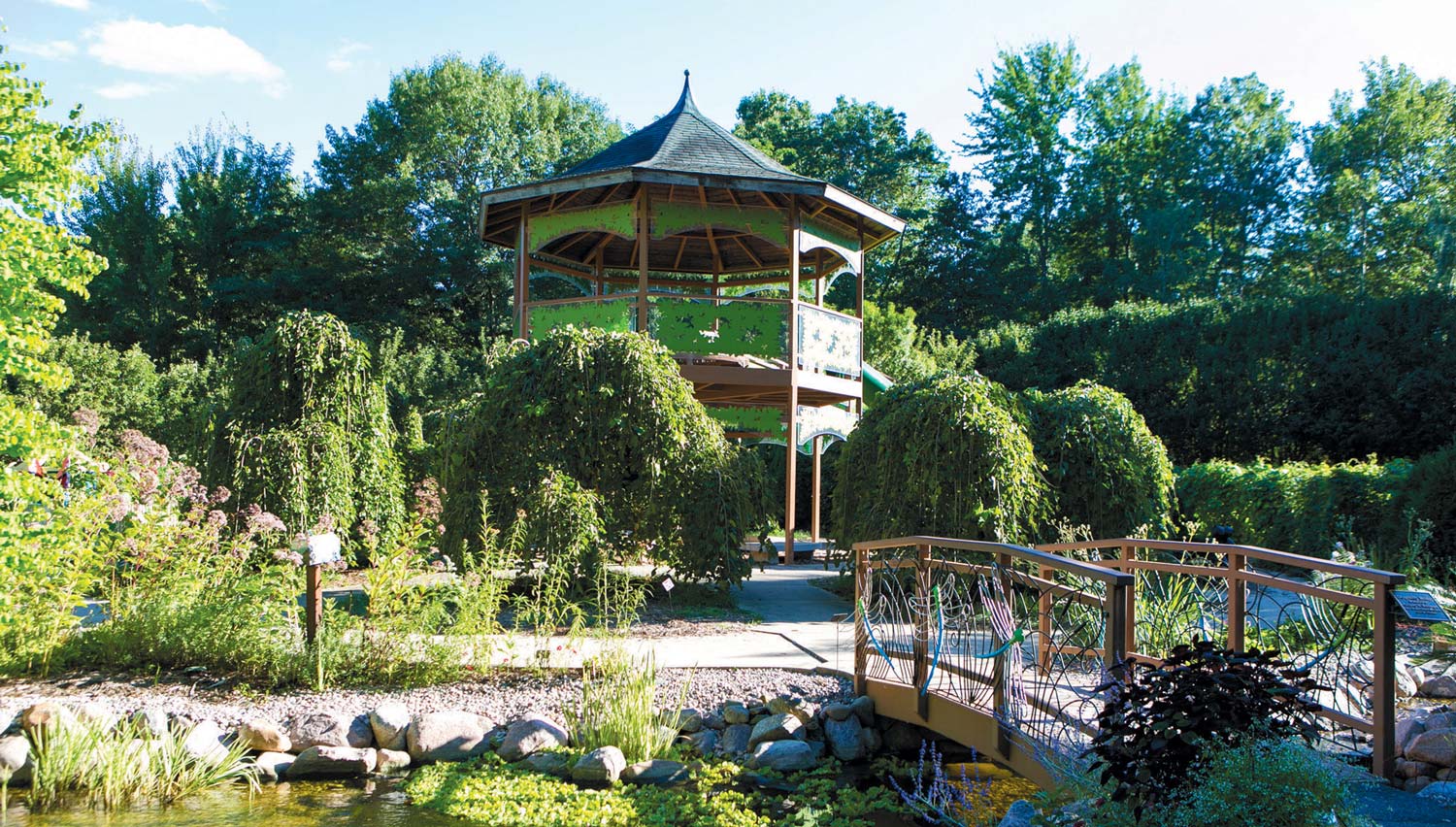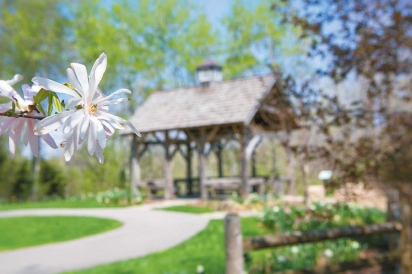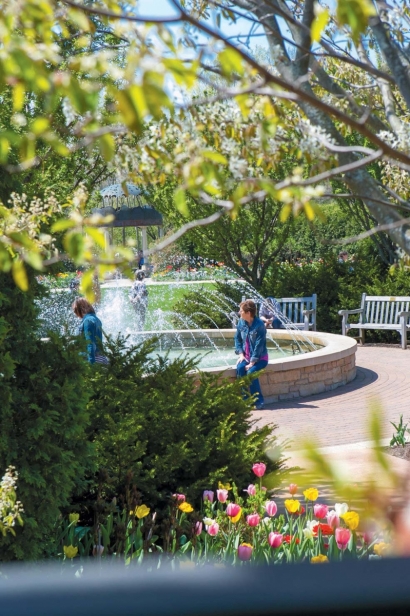The Ever-Changing Botanical Garden
Spring in the garden is one of the most exciting times of year. “We plan for this all winter. When spring finally arrives, everything comes to life. It’s an explosion of color,” says Susan Garot, executive director of the Green Bay Botanical Garden.
The nonprofit organization is deeply rooted in the community; it celebrated its 20th anniversary just last year. However, these gardens were dreamt of long before they opened in 1996.
In the late 1970s, a dedicated team began the search for the perfect location. Just a few years later, Green Bay Botanical Garden incorporated as a nonprofit, but they did not sign a lease for the grounds of Northeast Wisconsin Technical College until 1987. It took another nine years of fundraising, planning and building before the garden opened to the public.
The land has been carefully nurtured over the years to highlight many of the region’s native plants and specialty flowers, fruits and vegetables. Trails run through the 47 acres. Half of that land has been developed and planted. Wetlands cover much of the rest of the grounds.
“There are many beautiful native plants in the existing wetlands,” says Mark Konlock, director of horticulture. “We hope to eventually build a boardwalk system, with the blessing of the Wisconsin Department of Natural Resources, in order to allow visitors to appreciate and enjoy the beauty of the wetland ecosystems we have at the Green Bay Botanical Garden. In spring there are literally thousands, if not tens of thousands, of marsh marigolds that bloom on the property as well as other interesting plants and animals to observe.”
The developed land is organized into over 20 different gardens. Each has its own distinct theme and style. Herbs, vegetables and traditional flowers are used to create the type of garden you would find beside an old English cottage in the Vanderperren Cottage Garden. Apple trees and bluegrass sprinkle the Larsen Orchard Remnant. The Kress Oval Garden mixes perennials with a traditional rose garden. Flowering trees, hostas and shade perennials fill a peaceful glen in the King Shade Garden.
One of the most interactive gardens is the Gertrude B. Nielsen Children’s Garden. In many ways, it represents the learning soul of the botanical garden.
“The Children’s Garden provides a very sensory experience for children, engaging all five senses in their learning,” says Garot. “We have a Wetting Zoo, where the children can water the topiary animals while learning about water conservation and rain barrels; Mc-Gregor’s Farm teaches kids about growing vegetables; the sensory garden features plants that are designed to appeal to their sense of sight, sound, touch, taste and smell; a wonderful sundial to teach them time; the koi pond to learn about pond plant life; a butterfly house where we grow butterfly-friendly plants that attract these beauties; and of course a fabulous slide, where they wind their way through a maze to climb to the top.
“We want this to be a garden for all ages. Education is a primary part of our work,” she says, explaining how they bring that love of learning out of the garden and into the community through outreach programs like Nature’s Lunchbox. “Visiting schools gives us a chance to show kids where their food comes from. They learn how to identify which parts of the plants they are eating.”
Sustainability is a key focus for Green Bay Botanical Garden. The organization’s land and buildings have the Travel Green Wisconsin Certification, which they achieved through significant outdoor and indoor conservation practices.
To significantly reduce the chemicals used on the land, chemical fertilizers have been replaced by select compost in the rose collections. Turf areas are being transitioned with no-mow seed mixes, which decreases the use of fossil fuels.
Avoiding the use of pesticides and chemicals means time-intensive work. A devoted team of staff and volunteers pull weeds and water the majority of the plants by hand with a watering wand. “Every plant has different needs. They’re particular,” says Konlock. “By watering by hand, we can control how much they receive based on their needs each day. We can factor in the weather and how healthy each plant is. We estimate that it takes about 100 hours a week for collecour team to water all of the plants by hand, but it’s worth it.”
“Our volunteers are wonderful. They do so much for the gardens. Dozens [of volunteers] come throughout the week to help our staff. In fact, there are regulars who come on the same day each week,” says Garot with a smile. The garden has integrated natural methods into their maintenance, including cutting the plant back, hand-picking insects or spraying them with streams of water.
There are also likely many beneficial insects that call Green Bay Botanical Garden home that might take care of a problem. If that doesn’t work, insecticide may be used or sometimes just getting rid of the plant.
As any gardener knows, designing the landscape takes a deep understanding of both science and art.
Konlock designs the gardens by first determining which plants will flourish in each setting. Soil, shade and the surrounding vegetation all factor into a plant’s success.
“Climate also plays a role. We’re pretty safe with zone 5 plants,” he says, referencing the USDA Plant Hardiness Zone Map, which uses the average annual minimum winter temperature in an area to determine which plants are most likely to thrive there.
Keeping these elements in mind, Konlock photographs the gardens regularly to determine which areas need to be filled in. This allows him to make choices for the next season and to be creative with the landscape through color, size and shape.
One of the newest additions to the Green Bay Botanical Garden will be the Grand Garden and Amphitheater, which will open this summer and will host up to 1,500 people. The Grand Garden will be surrounded by a unique magnolia collection made up of over 130 species. Konlock and his team also plan to weave native plants in among the magnolias. “This was actually part of the original vision before the gardens began,” says Garot. “This garden will attract a whole new group of people by marrying the performing arts with nature.
The Grand Garden will feature musical, theatrical and other performing artists from local to national talent to perform in an environment designed to engage all senses of its audience. There will be nothing like it in the state of Wisconsin.”
The Green Bay Botanical Garden is magical throughout the year. During spring, summer and fall, the greenery is in constant bloom, while in the winter the Garden of Lights takes center stage. Classes, culinary events and school tours keep the gardens active. With a strong membership, support from the community and out-of-state tourists they welcome more than 130,000 annual visitors. To keep the gardens fresh, staff phase in new plants as the old ones wane. It transforms the scenescape frequently. With 47 acres to explore, it will take more than one trip to experience it all.
“The garden changes regularly throughout the year. You’ll never experience the same garden twice,” Garot says. “Visit us often!”







